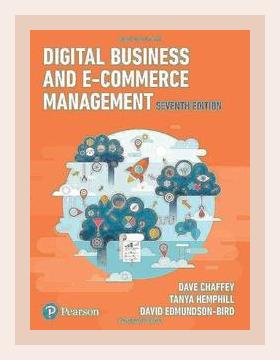Technology and Digital TransformationE-commerce
detailed summary of “Digital Business and E-Commerce Management” by Dave Chaffey with specific examples and actionable steps. This summary will be structured into key sections based on the major themes and points presented in the book.
1. Introduction to Digital Business and E-commerce
Summary: The book begins by laying out the foundational concepts of digital business and e-commerce. Dave Chaffey defines digital business as the broader concept encompassing various online and electronic transactions, while e-commerce specifically refers to the buying and selling of goods and services online.
Example: Chaffey introduces companies like Amazon and eBay as pioneers of e-commerce, setting the stage for understanding the vast potential of digital business platforms.
Actionable Step: Start by clearly defining the scope of your digital business. Are you focusing on pure e-commerce, or are you seeking a broader digital transformation? Knowing your focus will help prioritize your strategy and resources accordingly.
2. E-commerce Business Models
Summary: The different e-commerce business models are discussed in detail, including Business-to-Consumer (B2C), Business-to-Business (B2B), Consumer-to-Consumer (C2C), and Consumer-to-Business (C2B).
Example: For B2C, Chaffey discusses retail giants like Amazon. For B2B, he uses Alibaba as a case study. The book also illustrates the C2C model through platforms like eBay and Craigslist, and the C2B model through market research companies buying data from consumers.
Actionable Step: Assess which business model fits your company. If you’re a manufacturer, a B2B model could work. For selling to end-users, a B2C model might be best. This clarity guides business planning and marketing strategy.
3. E-commerce Strategy Development
Summary: Chaffey emphasizes the need for an integrated e-commerce strategy that aligns with the overall business objectives. The strategic development process involves market analysis, setting objectives, and developing a detailed plan.
Example: He illustrates this with Zara’s online strategy, which integrates seamlessly with its physical stores to provide a cohesive customer experience.
Actionable Step: Conduct a SWOT analysis (Strengths, Weaknesses, Opportunities, Threats) for your business to identify key areas to focus on. Use this analysis to develop clear, achievable goals.
4. Digital Marketing and Customer Acquisition
Summary: The book provides an in-depth look at digital marketing techniques, including Search Engine Optimization (SEO), Pay-Per-Click (PPC) advertising, social media marketing, and email marketing.
Example: Chaffey highlights SEO strategies using content marketing and keyword optimization, like how Moz leverages blogs to drive organic traffic.
Actionable Step: Develop a content marketing calendar that aligns with SEO best practices. Regularly publish keyword-optimized blog posts to attract and engage your target audience.
5. User Experience and Conversion Optimization
Summary: Ensuring a smooth and engaging user experience (UX) is crucial for e-commerce success. Chaffey details best practices for website design, usability, and conversion rate optimization (CRO).
Example: The book cites Apple’s website design principles, focusing on simplicity and user-friendliness, contributing to higher conversion rates.
Actionable Step: Conduct regular usability testing on your website to identify pain points. Implement A/B testing to compare different design elements and optimize for better user engagement and conversion rates.
6. Technology and Infrastructure
Summary: Chaffey explores the technological backbone of e-commerce, highlighting the importance of robust and scalable infrastructure to support digital business activities.
Example: He uses Amazon Web Services (AWS) as an example of scalable infrastructure enabling companies of all sizes to leverage cloud computing technology.
Actionable Step: Evaluate your current technology stack and identify areas where cloud services can enhance scalability and reliability. Consider integrating cloud-based solutions to support your business growth.
7. Security and Legal Considerations
Summary: Protecting customer data and ensuring compliance with legal standards are essential for maintaining trust and avoiding legal issues. Chaffey discusses various security protocols and legal requirements.
Example: He details the impact of data breaches on businesses using Target’s data breach incident, underscoring the need for robust security measures.
Actionable Step: Implement SSL certificates and regularly update security protocols to safeguard customer data. Stay informed of relevant legal regulations such as GDPR or CCPA and ensure compliance.
8. Online Retailing and Service Sector
Summary: The dynamics of online retailing and the service industry are dissected to highlight unique challenges and opportunities. Chaffey covers logistics, customer service, and returns management.
Example: The book explains how Zappos differentiates itself through exceptional customer service and hassle-free returns, cultivating strong customer loyalty.
Actionable Step: Invest in a responsive customer support system and create a clear, customer-friendly returns policy. Use customer feedback to continuously improve service offerings.
9. Social Media and Consumer Empowerment
Summary: Social media platforms are powerful tools for engaging consumers and building brand communities. Chaffey delves into strategies for leveraging social media for marketing and customer interaction.
Example: He showcases how brands like Starbucks use social media to foster a sense of community and engage customers through interactive campaigns.
Actionable Step: Create a social media strategy that includes regular posts, engagement with followers, and interactive campaigns. Use analytics to measure the effectiveness of your social media efforts and adjust accordingly.
10. Performance metrics and Analytics
Summary: Measuring the performance of your digital business is critical for understanding success and areas for improvement. Chaffey outlines key metrics and analytics tools to track performance.
Example: He cites Google Analytics as an essential tool for monitoring website traffic, user behavior, and conversion rates.
Actionable Step: Set up Google Analytics or a similar tool on your website. Regularly review key metrics such as traffic sources, bounce rates, and conversion rates to gain insights and make informed decisions to improve digital performance.
Conclusion
Summary: Chaffey concludes by stressing the importance of continuous learning and adaptation in the ever-evolving digital landscape. Staying up-to-date with technological advancements and consumer trends is vital for long-term success.
Actionable Step: Commit to ongoing education through industry blogs, webinars, and conferences. Encourage your team to stay informed and continuously seek out new opportunities for innovation and improvement.
By following the key points and actionable steps outlined in Chaffey’s “Digital Business and E-commerce Management,” businesses and entrepreneurs can develop a comprehensive and effective digital strategy tailored to their unique needs and objectives.
